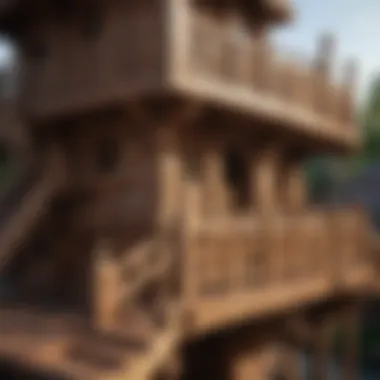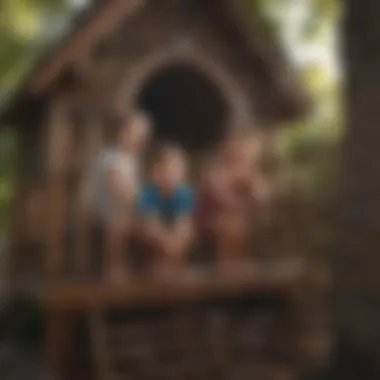In-depth Exploration of Wooden Playforts: Design, Benefits, and Maintenance Tips


Playhouse Overview
Wooden playforts offer a captivating world of imagination and adventure for children, transcending ordinary play structures. From classic designs to elaborate creations, playhouses come in various styles to cater to different preferences and needs. Traditional cottage-style playhouses evoke a sense of nostalgia, while modern treehouse-inspired structures provide an element of novelty and excitement. Whether shaped like a cozy cabin or a whimsical castle, these playforts serve as havens for creativity and play.
Features and Benefits
Wooden playforts boast an array of features and benefits that make them a standout choice for enriching children's play experiences. Durability is a key aspect, with well-crafted playhouses enduring rough and tumble play sessions with ease. Safety measures such as rounded edges and sturdy construction ensure peace of mind for parents. Moreover, these playforts stimulate children's imaginations, offering a blank canvas for endless storytelling and role-playing adventures.
Buying Guide
When considering a wooden playfort for your child, several factors come into play to ensure the perfect fit. The material of the playhouse plays a crucial role in its longevity and aesthetics, with options ranging from natural cedar to eco-friendly composite materials. Size matters too, with compact cottages ideal for smaller spaces and expansive structures perfect for larger yards. Choosing a theme that resonates with your child's interests can ignite their creativity and love for their play space, while interactive elements like slides and climbing walls add an extra layer of fun and engagement.
Maintenance Tips
Proper maintenance is key to preserving the beauty and functionality of a wooden playfort. Regular cleaning using mild soap and water helps remove dirt and grime, ensuring a fresh and inviting play environment. Storing playhouse accessories in a dry, sheltered area when not in use prevents damage from the elements, prolonging their lifespan. Inspecting the playfort for any signs of wear and tear allows for timely repairs, keeping the structure safe and enjoyable for years to come.
Customization Options
Personalizing a wooden playfort adds a touch of uniqueness and charm to the play space, offering children a sense of ownership and creativity. Paint your own playhouse kits make for a fun artistic expression activity, allowing kids to customize their playhouse with vibrant colors and designs. DIY playhouse kits not only foster family bonding through building but also provide a sense of accomplishment upon completion. For a truly tailored play experience, building your own playhouse allows for custom designs and features that cater to specific preferences. Enhancing the play space further, unique accessories such as flower boxes, door signs, and fairy lights add personality and functionality to the wooden playfort.
Introduction to Wooden Playforts
Wooden playforts hold a special place in the realm of childhood play experiences, offering a blend of fun, creativity, and developmental benefits. In this detailed article, we embark on a journey to unravel the significance of wooden playforts. These structures are not mere play spaces; they serve as catalysts for physical activity, imagination, and social interaction. Parents and guardians, DIY enthusiasts, and home improvement hobbyists will find valuable insights into the world of wooden playforts, understanding their pivotal role in fostering holistic child development.
Understanding the Concept of Playforts
Defining Playforts
Defining playforts goes beyond structures; it encompasses a realm of infinite possibilities for children's play. These bespoke areas encourage hands-on exploration and adventure, promoting both physical and cognitive development. The flexibility and personalization options of playforts make them a top choice for enhancing play experiences, granting children a safe yet stimulating environment to thrive.
The Evolution of Playforts


The evolution of playforts showcases a shift towards more innovative designs and features. From traditional wooden fortresses to modern-day multifunctional play structures, the evolution signifies a continued commitment to enriching children's play experiences. The adaptability of playforts to meet contemporary needs while retaining their timeless charm positions them as an enduring choice for families seeking quality play solutions.
Importance of Playforts in Child Development
Playforts play a vital role in nurturing essential skills in children. Their contribution to physical development, cognitive abilities, and social skills cannot be understated. By engaging in imaginative play within the confines of a playfort, children learn to problem-solve, communicate effectively, and collaborate with peers. The intrinsic value of playforts in supporting holistic child development makes them a valuable addition to any play environment.
Benefits of Wooden Playforts
Wooden playforts offer a myriad of significant benefits that contribute to the holistic development of children. In this article, we will delve into the specific elements that make wooden playforts a valuable addition to children's play experiences. From enhancing physical and cognitive development to fostering emotional and social growth, wooden playforts play a crucial role in shaping children's well-being.
Physical and Cognitive Development
Encouraging Physical Activity
Encouraging physical activity through wooden playforts is essential for promoting a healthy lifestyle among children. The playforts provide a stimulating environment that encourages kids to engage in active play, fostering their physical development. By climbing, swinging, and exploring various play elements within the fort, children enhance their balance, coordination, and overall physical fitness. This engagement with physical activities not only promotes health but also instills a love for movement from an early age.
Boosting Creativity and Imagination
Wooden playforts serve as a canvas for children's creativity and imagination to flourish. Through pretend play and storytelling, kids transform the playfort into a mystical castle, a spaceship, or a secret hideout, stimulating their imaginative capabilities. The open-ended nature of playforts encourages children to invent scenarios, problem-solve, and think outside the box, fostering cognitive skills such as critical thinking and creativity.
Enhancing Problem-Solving Skills
Engaging with wooden playforts presents children with challenges that require problem-solving skills. From figuring out the best way to climb to the top of the fort to planning role-playing scenarios with friends, children exercise their critical thinking abilities. By facing obstacles and finding creative solutions within the playfort environment, kids develop analytical skills, perseverance, and the confidence to tackle challenges both inside and outside of play.
Emotional and Social Benefits
Building Confidence and Independence
Wooden playforts serve as a space where children can test their boundaries, take risks, and build confidence in their abilities. Through independent play within the fort's confines, kids learn to make decisions, navigate social interactions, and assert their autonomy. This sense of independence fosters self-esteem and resilience, laying a strong foundation for healthy emotional development.
Fostering Social Interaction
Wooden playforts provide a platform for social interaction and collaboration among children. Whether engaging in imaginative play scenarios with peers, sharing adventures, or taking turns on play equipment, kids hone their social skills within the playfort setting. By learning to communicate, cooperate, and negotiate with others, children develop essential interpersonal skills that contribute to their social growth and overall well-being.


Promoting Emotional Well-being
The emotional well-being of children is nurtured through the safe and comforting environment of wooden playforts. These play structures offer a retreat where kids can express themselves freely, unwind, and recharge after a busy day. The sense of ownership and personal space within the playfort promotes emotional regulation and relaxation, fostering a positive outlook and emotional resilience in children.
Maintenance and Care Tips for Wooden Playforts
Maintaining and caring for wooden playforts is crucial to ensure their longevity and safety. In this section, we will delve into essential tips for preserving these cherished structures that enrich children's play experiences.
Regular Inspections and Cleaning
Checking for Wear and Tear
Checking for wear and tear is a fundamental aspect of maintaining wooden playforts. Regular inspections can help identify any signs of damage or deterioration, allowing for timely repairs to uphold structural integrity. This proactive approach not only extends the lifespan of the playfort but also safeguards children from potential hazards. The unique feature of checking for wear and tear is its preventative nature, addressing issues before they escalate, thereby ensuring a safe play environment.
Cleaning and Preserving Wood
Cleaning and preserving wood play a significant role in maintaining the aesthetics and structural strength of wooden playforts. Proper cleaning techniques help remove dirt, grime, and debris that can degrade the wood over time. Additionally, preserving wood with suitable coatings or treatments protects against moisture and UV damage. The key characteristic of cleaning and preserving wood is its ability to enhance the natural beauty of the wood while shielding it from environmental factors, thus prolonging the playfort's lifespan.
Ensuring Structural Stability
Ensuring structural stability is paramount for the safety of children using wooden playforts. Regularly checking the integrity of the foundation, fastenings, and components can prevent accidents and malfunctions. By reinforcing weak areas and conducting necessary repairs, structural stability is maintained, providing a secure play environment. The unique feature of ensuring structural stability lies in its focus on preemptive measures to avoid structural failures, emphasizing the importance of proactive maintenance practices.
Weatherproofing Strategies
Weatherproofing strategies are essential for preserving wooden playforts amidst varying weather conditions. Implementing effective strategies can shield the playfort from moisture damage, pests, and seasonal weather challenges.
Applying Sealants and Stains
Applying sealants and stains is a recommended practice to protect the wood from moisture infiltration and UV radiation. Sealants create a barrier that prevents water seepage, while stains enhance the appearance of the wood and offer additional protection. The key characteristic of applying sealants and stains is their ability to fortify the wood against external elements, ensuring its durability and resistance to weather-related wear.
Protecting Against Moisture and Pests
Protecting wooden playforts against moisture and pests is vital for preventing wood rot and insect infestations. By employing methods such as moisture barriers and pest-resistant treatments, the playfort's structural integrity is safeguarded. This proactive approach helps maintain a healthy environment within the playfort, promoting longevity and minimizing potential damage. The unique feature of protecting against moisture and pests is its dual role in preserving the wood and ensuring the safety of children using the play structure.


Seasonal Maintenance Practices
Implementing seasonal maintenance practices is crucial for adapting the playfort to changing environmental conditions. Seasonal variations can impact the wood's condition, making regular maintenance imperative.
By following specialized maintenance routines tailored to each season, such as inspecting for winter damage or reapplying protective coatings in summer, the playfort remains resilient throughout the year. The key characteristic of seasonal maintenance practices is their ability to address seasonal challenges proactively, mitigating potential wear and tear while maximizing the playfort's longevity.
Safe Play Guidelines
Establishing safe play guidelines is essential to promote responsible play and minimize potential risks for children engaging with wooden playforts. By setting rules, providing supervision, and educating children on safety measures, a secure and enjoyable play environment can be ensured.
Setting Rules for Play
Setting rules for play establishes boundaries and expectations for children using the playfort, guiding their behavior and interactions. By defining guidelines for activities, equipment usage, and group play, potential hazards can be minimized. The key characteristic of setting rules for play is its role in fostering a safe and structured play environment, promoting positive play experiences while prioritizing safety.
Supervision and Monitoring
Providing adequate supervision and monitoring is essential to oversee children's activities within the playfort and intervene promptly in case of emergencies. By maintaining a watchful eye and being alert to potential risks, caregivers can ensure a safe play environment for children. The unique feature of supervision and monitoring is its proactive nature, enabling quick responses to ensure the well-being of children during play.
Teaching Children About Safety
Educating children about safety practices and guidelines instills awareness and responsibility regarding playfort usage. By explaining potential dangers, demonstrating safe behaviors, and encouraging open communication, children can learn how to navigate risks effectively. The key characteristic of teaching children about safety is its emphasis on empowering children with knowledge and skills to make informed decisions, fostering independence while promoting a culture of safety within the play environment.
Conclusion
In concluding this comprehensive guide on the world of wooden playforts, it is evident that these structures hold immense significance in enhancing children's play experiences. By exploring the various aspects of wooden playforts, from design considerations to benefits and maintenance tips, readers can gain a deeper understanding of how these timeless structures can positively impact a child's development and overall well-being. Embracing the world of wooden playforts is not just about creating a fun play space but also about investing in a child's growth and creating lasting memories that will be cherished for years to come.
Embracing the World of Wooden Playforts
Encouraging Playful Adventures
Encouraging playful adventures through wooden playforts allows children to engage in imaginative and active play, fostering creativity and physical activity simultaneously. The key characteristic of encouraging playful adventures is its ability to spark curiosity and exploration in children, providing a safe yet exciting environment for them to express themselves freely. The unique feature of this aspect is that it encourages children to step out of their comfort zones, take risks, and develop problem-solving skills in a playful setting. The advantages of encouraging playful adventures in wooden playforts include promoting a sense of independence, enhancing cognitive abilities, and instilling a love for outdoor play.
Investing in Children's Development
Investing in children's development through wooden playforts goes beyond providing a play structure – it is about nurturing a child's physical, emotional, and social growth. The key characteristic of investing in children's development is its ability to offer a multi-dimensional platform for learning and self-discovery. This aspect is a popular choice for this article because it highlights the holistic benefits that wooden playforts can offer, from enhancing motor skills to fostering emotional intelligence. The unique feature of this aspect is that it encourages parental involvement and support in a child's development journey, promoting bonding and mutual learning. The advantages of investing in children's development through wooden playforts include promoting teamwork, building resilience, and creating a strong sense of accomplishment in children.
Creating Lasting Memories
Creating lasting memories through wooden playforts encapsulates the essence of childhood joy and exploration. The key characteristic of creating lasting memories is its ability to forge strong emotional connections and nostalgia that children can carry into adulthood. This aspect is a beneficial choice for this article because it underscores the enduring impact that play experiences have on shaping a child's identity and beliefs. The unique feature of creating lasting memories is that it cultivates a sense of belonging and security in children, providing a scaffold of positive experiences to draw upon in later years. The advantages of creating lasting memories through wooden playforts include enriching family bonds, fostering creativity, and instilling a love for nature and the great outdoors.



